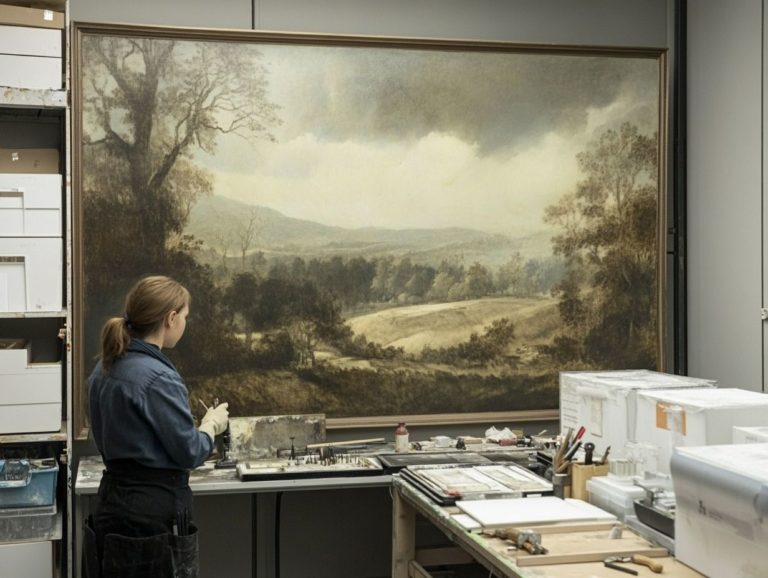5 Reasons to Start Collecting Art Today
Art transcends mere decoration; it has the power to transform your space, uplift talented creators, and even serve as a savvy financial investment.
Whether you re an experienced collector or just dipping your toes into the art world, now is the perfect time to dive into art collecting! Collecting art brings a wealth of benefits, from elevating your home s aesthetic to igniting captivating conversations.
This article presents five compelling reasons for you to start your collection today and provides valuable insights to help you navigate this exhilarating journey.
Contents
Key Takeaways:
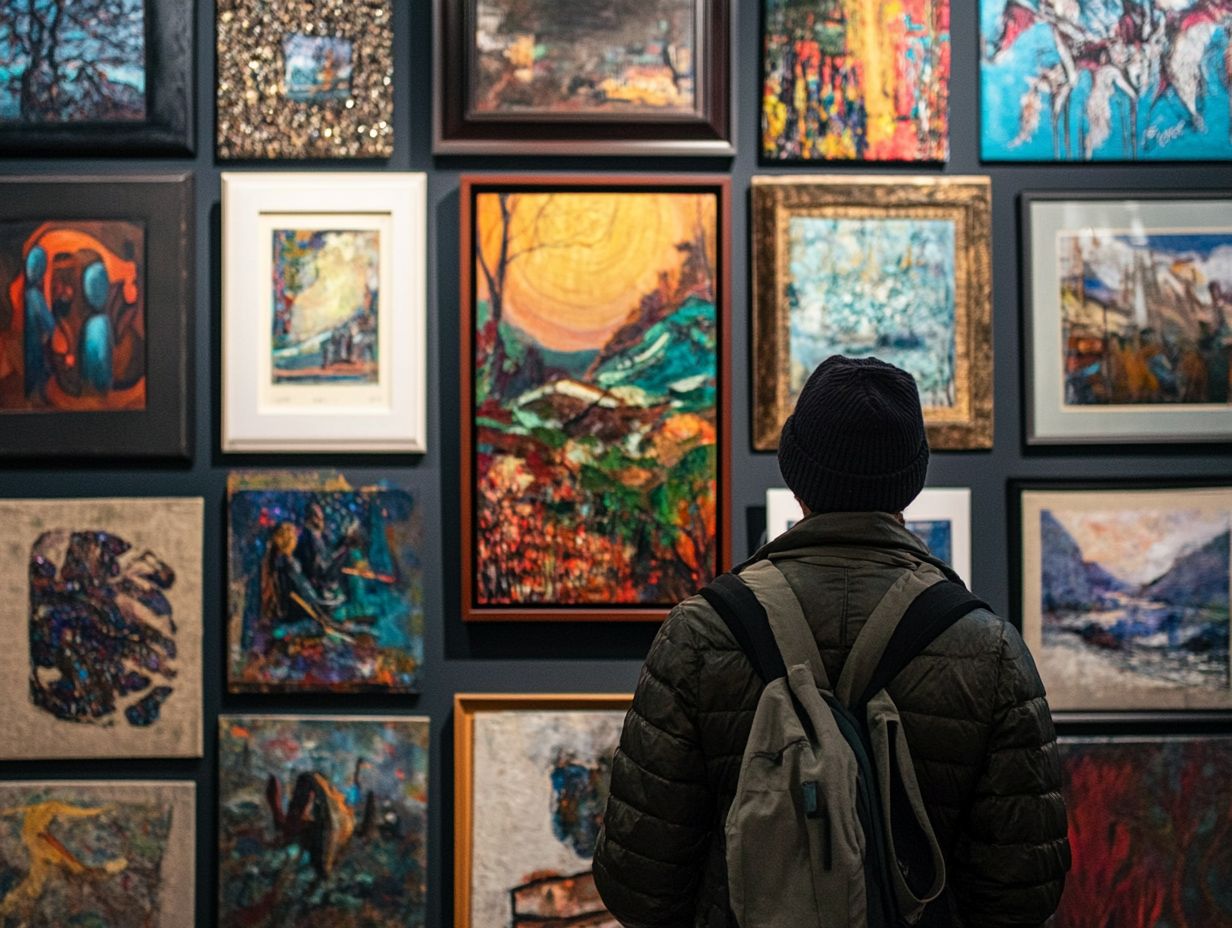
- Invest in your future by collecting art that can increase in value.
- Transform your space with visually stimulating art pieces.
- Support emerging artists by purchasing their work.
1. Art Can Be a Good Investment
Investing in art is a smart way to appreciate beauty and grow your wealth. It allows you to indulge in aesthetic enjoyment while also creating a lasting legacy through unique pieces and meaningful collections.
Art collecting is a remarkable opportunity to diversify your investment portfolio, especially with the diverse artistic styles gaining traction today.
Whether you re drawn to contemporary abstract works, classic photography, or innovative installations, there s a spectrum of genres that can align with your taste and promise potential returns.
The auction process shapes market values and establishes benchmarks for future sales. Esteemed houses like Sotheby s and Christie s are platforms where works by artists such as Banksy and Yayoi Kusama have witnessed dramatic appreciation.
This blend of personal passion and financial savvy appeals not only to those who love art but also to discerning investors keen to navigate the evolving art world.
2. Enhances Your Home or Office Space
Incorporating art into your home or office elevates the aesthetic and reflects your personal identity and artistic expression. This creates an environment that sparks creativity and engagement.
The impact of original artwork can be transformative, turning a mundane room into a vibrant hub of inspiration.
Picture a striking landscape painting in your corporate office, infusing energy into the workspace and motivating everyone to think outside the box.
Unique sculptures or handcrafted wall art can serve as enticing conversation starters, fostering connections among colleagues and clients alike.
Beyond mere decoration, visual arts nurture an appreciation for creativity and encourage personal growth through exposure to diverse mediums and styles.
3. Supports Emerging Artists
By collecting and investing in the works of emerging artists, you actively nurture artistic evolution. Your support is crucial in enabling new talent to flourish within the art community.
This grants these artists valuable exposure and enriches the cultural landscape around you. Gallery representation is essential, providing a platform for these creators to present their work to a wider audience, inviting recognition and meaningful dialogue.
Organizations like 1-54 Contemporary African Art Fair and The Armory Show prioritize shining a light on emerging talents, significantly aiding the launch of their careers.
As an art patron, your funding or mentorship can open doors for these artists, ensuring that diverse voices continue to enhance the ever-evolving tapestry of contemporary art.
4. Can Be a Conversation Starter
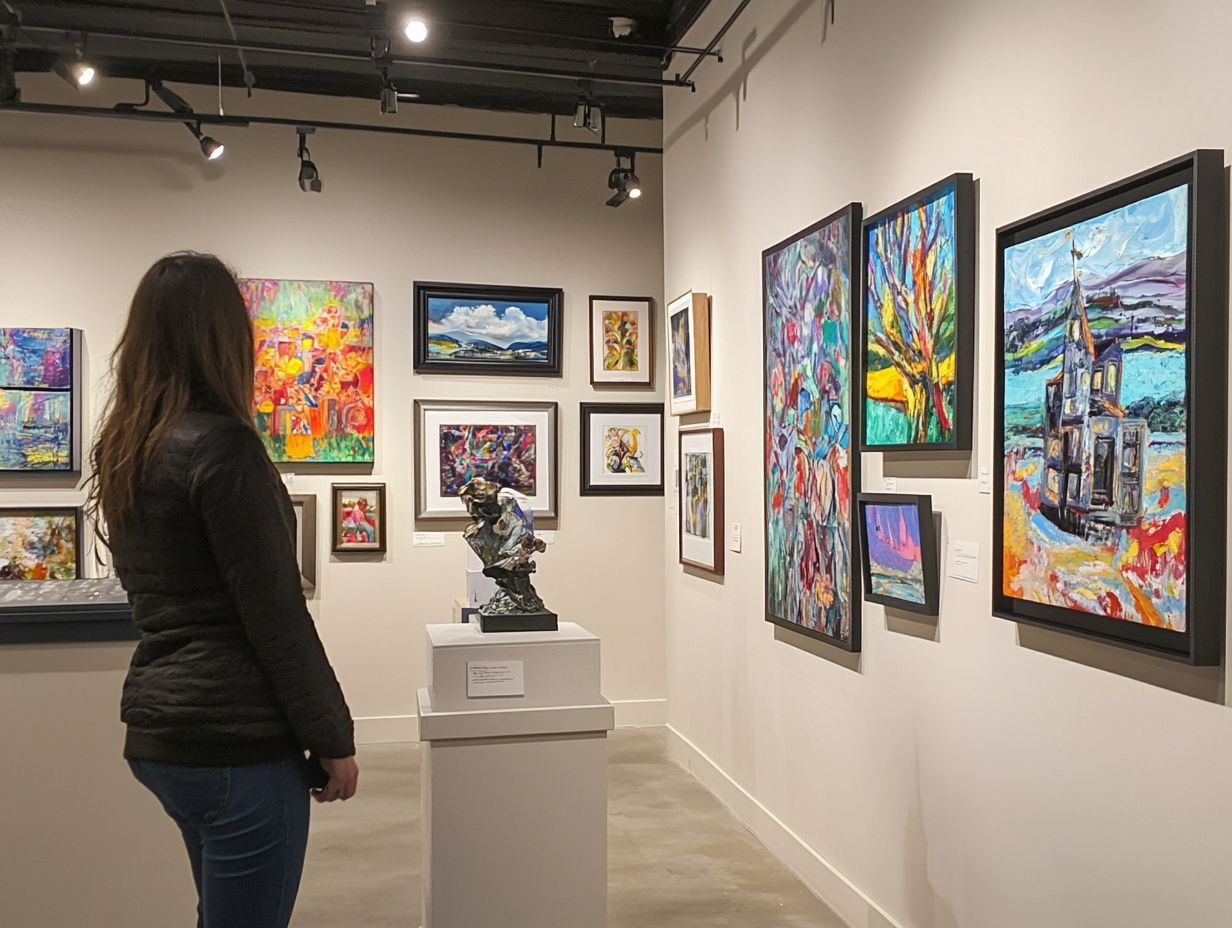
Art acts as a compelling conversation starter. It invites you to explore discussions that weave together cultural heritage and personal experiences, enriching the collector community.
By examining how various artworks reflect their historical contexts, you can uncover deeper insights. For example, discussing impressionism can unveil the societal shifts of the late 19th century, enhancing your understanding.
To foster engaging conversations about art appreciation, consider asking open-ended questions. What emotions does a particular piece evoke? How does its style align with contemporary trends?
Let s share personal interpretations! It makes the dialogue richer and more enjoyable, creating connections that deepen your appreciation for the beauty of artistic expression.
5. Provides a Creative Outlet
Engaging with art nurtures your artistic expression. It also provides a creative outlet that encourages personal growth and intellectual development.
In workshops focused on painting, sculpting, or mixed media, you can dive deep into your thoughts and feelings. Transform them into tangible works of art.
Imagine a community pottery class where you shape clay into forms that tell your unique story. Or a digital art workshop that inspires you to address contemporary issues through innovative visuals.
These interactive experiences elevate your creativity and help you uncover your personal identity. The journey of artistic exploration becomes profoundly transformative.
What Types of Art Can Be Collected?
The world of art collecting is a rich tapestry featuring various forms, including traditional art, digital creations, and the cutting-edge realm of non-fungible tokens (NFTs). This diversity allows you to curate a collection that reflects your aesthetic and values.
In this vibrant landscape, traditional mediums like painting and sculpture remain robust. Artists such as Yayoi Kusama captivate audiences with polka-dotted installations that invite reflection on perception and identity.
Meanwhile, modern photography is carving its space. The evocative works of Cindy Sherman delve into themes of identity and culture.
Digital art is transforming collector preferences, especially with the rise of NFTs. Pieces like Beeple s “Everydays: The First 5000 Days” have sold for astonishing sums, marking a significant shift in how value is perceived.
As trends evolve, you might find yourself increasingly open to integrating these innovative formats into your portfolio. Influenced by market dynamics and your own taste, you are part of a movement redefining the essence of art ownership.
How Can One Start a Collection on a Budget?
Starting an art collection on a budget is entirely achievable with thoughtful strategies.
Seek out emerging artists and participate in art auctions. Explore online platforms that offer unique pieces at accessible prices. Attending local exhibitions can be rewarding, as they often feature talented creators on the rise, allowing you to acquire original works at reduced rates.
Getting involved in art auctions adds an exhilarating twist to your journey. You might uncover hidden gems, snagging unique items for significantly less than their market value.
Online marketplaces like 1stDibs present options, including limited edition pieces and works by up-and-coming artists. By supporting these artists, you enhance your collection and contribute to the art community. Don t miss out on discovering amazing pieces that could be the highlight of your collection!
What Are the Benefits of Collecting Art from Different Time Periods or Cultures?
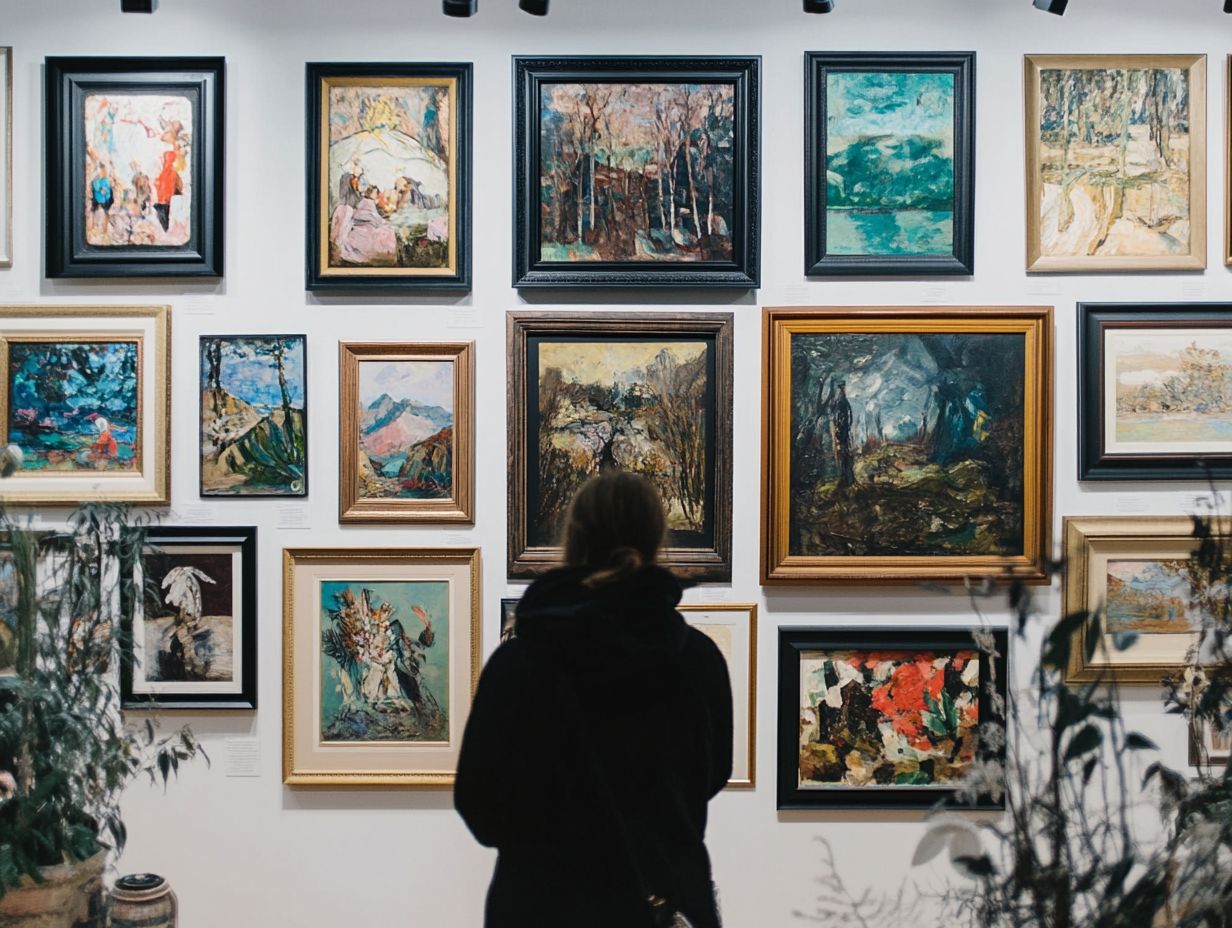
Collecting art across various time periods and cultures elevates your experience and deepens your appreciation for artistry. It enriches your understanding of artistic evolution and cultural heritage.
This diversity allows you to delve into your own identity and create a canvas for legacy building. A thoughtfully curated collection can stand as a testament to your personal values and perspectives.
By surrounding yourself with works that span different backgrounds and historical contexts, you uncover unique insights that challenge your viewpoints and spark your creativity. These pieces transcend mere decoration; they become conversation starters that bridge gaps between generations and communities, weaving a rich tapestry that mirrors the complexity of human experience and emotion.
How Can One Educate Themselves About Art and Artists?
Educating yourself about art and artists is a crucial step for any collector. This journey involves diving into art history, exploring various artistic styles, and immersing yourself in the vibrant collector community.
To deepen your understanding and appreciation of art, consider tapping into a range of resources tailored for aspiring collectors. Books like “Ways of Seeing” by John Berger and online courses on platforms such as Coursera or Skillshare can provide valuable insights into the techniques and philosophies that have shaped the art world.
Local art classes offer not just practical skills but also the opportunity to connect with fellow enthusiasts. Engaging in art exhibitions and community events provides firsthand experiences, allowing you to witness emerging talents and interact directly with artists.
Getting involved makes your art journey exciting and helps you appreciate art that speaks to you.
What Are the Potential Risks of Collecting Art?
While art collecting can offer remarkable investment potential and financial growth, it s important to acknowledge the possible risks, including the unpredictable nature of art market valuations and the complexities of the auction process.
Authenticity is a significant concern; forgeries and misattributed pieces can result in considerable financial losses. You must remain vigilant as the ever-evolving art market requires your attention to emerging trends and artist reputations.
To skillfully navigate these complexities, conducting thorough due diligence is essential. This involves researching provenance and relying on reputable appraisers. Engaging in collector clubs or attending gallery exhibitions can also enrich your understanding, enabling you to make informed decisions and mitigate risks when investing in captivating artworks.
How Can One Display and Preserve Their Art Collection?
Displaying and preserving your art collection requires thoughtful consideration of both aesthetics and environmental factors. You want to ensure each unique piece is showcased beautifully while safeguarding its integrity for future generations.
To achieve this, prioritize quality framing that enhances the artwork, using materials that minimize potential damage think acid-free mats and shatterproof glass. Lighting plays a crucial role as well; employing soft, indirect light can elevate the visual experience without risking fading or deterioration over time.
When hanging your artworks, aim to position them at eye level and keep them away from direct sunlight to prevent any harm.
Regularly engaging with the art community will provide you with invaluable insights on preservation techniques and innovative display methods, fostering a collective commitment to maintaining the beauty and longevity of your cherished pieces.
Frequently Asked Questions
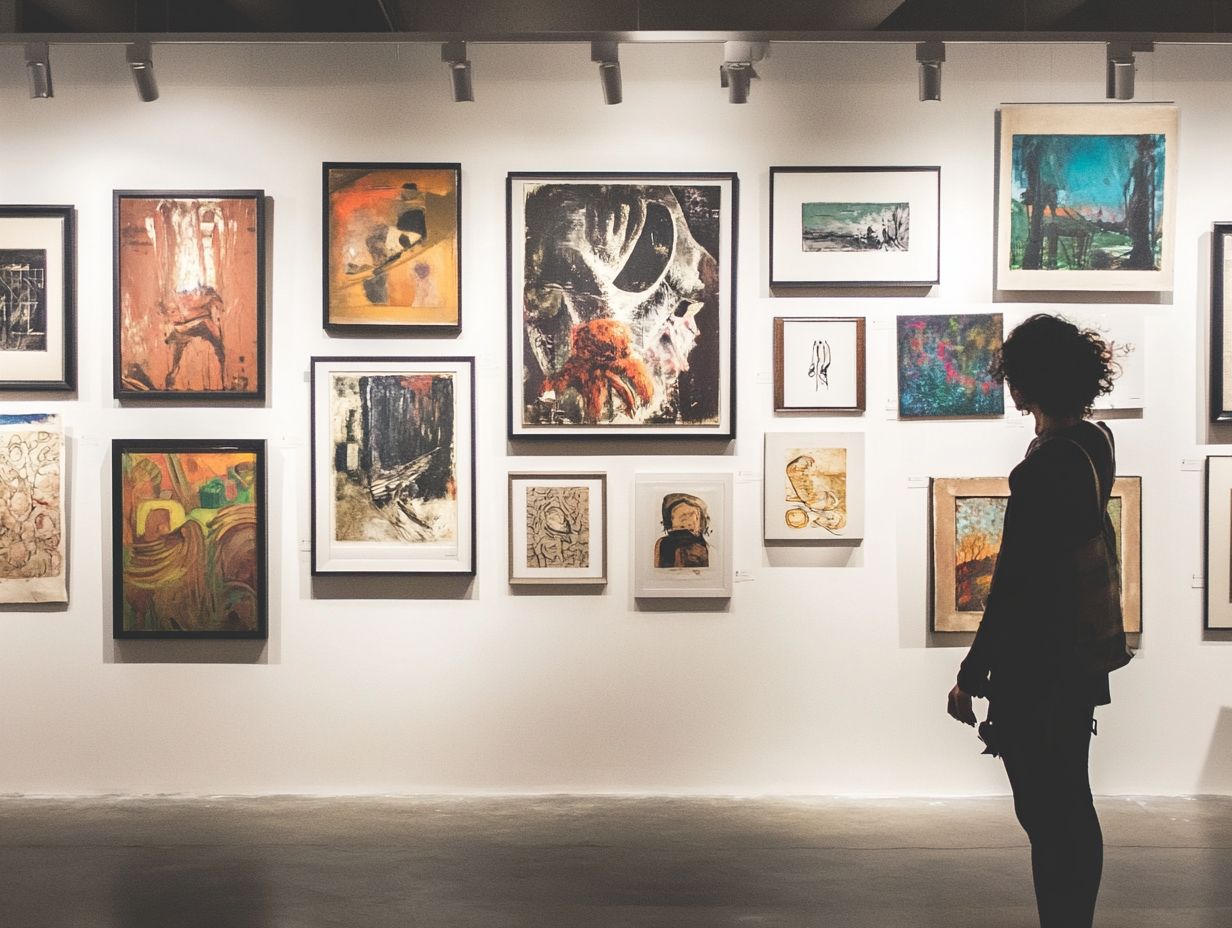
What Are the Benefits of Starting to Collect Art Today?
Collecting art today can bring numerous benefits, including:
- Enhancing your home or workspace with unique and beautiful pieces.
- Supporting and investing in emerging artists.
- Learning about different cultures and styles through art.
- Building a valuable and diverse collection over time.
- Enjoying the emotional and psychological benefits of surrounding yourself with art.
Do I need a lot of money to start collecting art?
No, you don’t need a lot of money to start. While some artworks can be pricey, many affordable options are available, like prints or smaller pieces from new artists.
Check out local art festivals or online marketplaces for budget-friendly finds!
What types of art can I collect?
The art world is diverse, with countless styles and mediums to explore. Think about what you love or ask experts for guidance.
From paintings and sculptures to photography and digital art, there’s something for every taste!
Is art collecting only for the wealthy?
No way! Art collecting is for anyone who appreciates beauty. While some pieces are expensive, many affordable options exist.
You can start with smaller pieces or invest in new artists, making it a budget-friendly choice.
How can I learn more about art and become a better collector?
Learning about art is a journey that can be rewarding. Visit galleries, attend art fairs, and read books on art history.
Seek advice from experts and join art communities to stay updated on trends!
Can collecting art be a profitable investment?
Yes, art can be a profitable investment, but it requires a long-term commitment. Art values can go up and down, so research is key.
Collecting should also be about personal enjoyment, not just making money!






